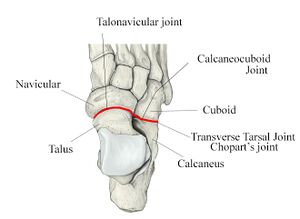Transverse Tarsal Joint (Chopart's Joint)
The transverse tarsal joint or midtarsal joint or Chopart's joint is formed by the articulation of the calcaneus with the cuboid (the calcaneocuboid joint), and the articulation of the talus with the navicular (the talocalcaneonavicular joint). This pair of joints separates the midfoot from the rearfoot (i.e. calcaneus and talus) by allowing the midfoot to move independently of the rearfoot. It works with the subtalar joint to control foot flexibility during the gait cycle.
Movement
The joint has two axes which provide motion in all three planes
- The longitudinal axis
- oriented 15° upward from the horizontal and 9° medially from the longitudinal axis of the foot.
- Inversion and eversion occur about the longitudinal axis.
- The oblique axis
- oriented 52° upward from the horizontal and 57° anteromedially.
- Flexion and extension occur primarily about this axis
The talonavicular joint generally has a higher range of motion than the calcaneocuboid joint. Precise measurements of range of motion are difficult to determine, but it is generally thought that it has similar amounts of pronation and supination as the subtalar joint.
Relationship with the Subtalar Joint
The transverse tarsal joint has the ability to perform the most pure form of pronation[notes 1] and supination[notes 2]. It allows the midfoot to conform to a variety of different positions depending on the terrain. The joint is considered to be part of the same functional unit as the subtalar joint because they share a common axis of rotation with contribution to inversion and eversion of the foot.
Inversion of the subtalar joint locks the transverse tarsal joint allowing for a stable hindfoot/midfoot during the toe-off phase of gait. Eversion of the subtalar joint unlocks the transverse tarsal joint allowing for a supple foot to accommodate the ground just after heel strike. The plantar aponeurosis is the primary structure of load/force transfer between hindfoot and forefoot during the stance phase.
The "tarsal mechanism" refers to pronation/supination at the subtalar joint driving motion at the midtarsal joint.
- The four bones (talus, calcaneus, cuboid, navicular) form an interlocking chain of motion, akin to the interlocking teeth of the cogs of a gearbox.
- The navicular and cuboid are almost immobile with respect to each other.
- During subtalar joint supination, the inversion and adduction forces generated by the calcaneus and applied to the cuboid are further transmitted to the navicular.
- With cuboid adduction and inversion underneath the foot, the navicular is lifted and abducted. This force is transmitted to the talus, further facilitating supination. There is a similar mechanism in reverse for subtalar joint pronation
Transverse joint locking
- Subtalar joint eversion: The major axes of the calcaneocuboid joint (longitudinal) and talonavicular joint (oblique) are in parallel when the subtalar joint is everted, thus allowing motion of the transverse tarsal joint in a “loose packed” position.
- Subtalar joint inversion: The axes of these joints are convergent with subtalar joint inversion (heel in varus), thus locking the transverse tarsal joint and providing rigidity to the midfoot in a “close packed” position.
- During midstance to toe-off, the foot becomes a rigid lever through inversion of the subtalar joint and resultant locking of the transverse tarsal joint.
Ligaments
The calcaneocuboid joint, which is part of the lateral longitudinal arch of the foot and takes the whole bodyweight, is stabilised by the below ligaments and is also reinforced by the peroneus longus tendon. This joint is part of the lateral longitudinal arch of the foot.
- Plantar calcaneocuboid ligament. This passes from the anterior inferior aspect of the calcaneus to the plantar surface of the cuboid behind the peroneal groove.
- Long plantar ligament. This runs along the whole lateral aspect of the foot. It originates from the tubercles of the calcaneus, and as it runs forward it produces a short attachment to the cuboid forming a roof over the peroneus longus tendon. It attaches to the bases of the lateral four metatarsal bones.
The talocalcaneonavicular joint is stabilised by the below ligaments along with the tibialis posterior tendon.
- Plantar calcaneonavicular ligament (spring ligament). This is a dense fibroelastic structure that runs from the sustentaculum tali to the navicular behind its tuberosity.
- Bifurcate ligament. This has two parts and runs from a deep recess on the upper surface of the calcaneus to the cuboid and navicular.
The bifurcate ligament is in two parts, and travels from a deep hollow on the upper surface of the calcaneus to the cuboid and navicular.
Clinical Applications
ATFL injuries can occur along with injury to the calcaneocuboid ligament. Pain may be reproduced by fixing the rearfoot in dorsiflexion and eversion, and then inverting and adducting the forefoot.
Notes
References
- Basic Biomechanics of the Musculoskeletal System - Nordin 4th edition 2012


